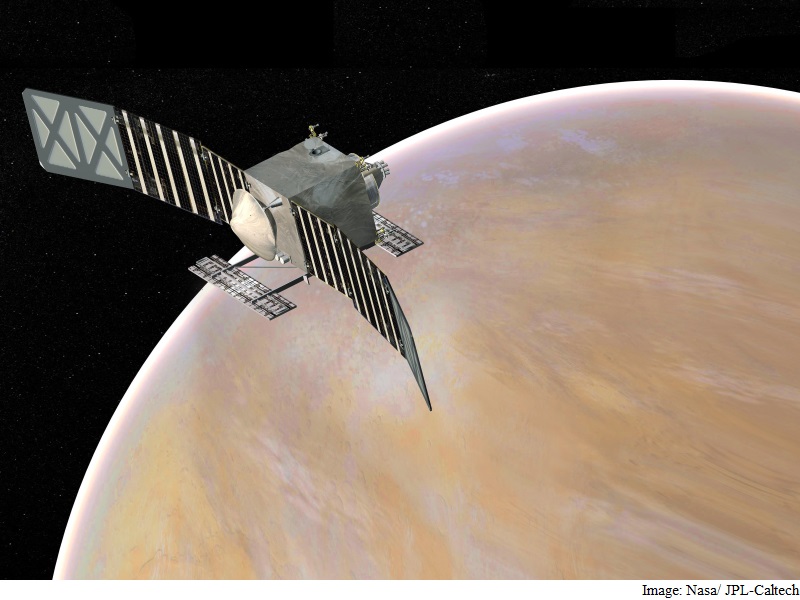- Home
- Science
- Science News
- New Nasa Missions to Venus and Near Earth Objects as Early as 2020
New Nasa Missions to Venus and Near-Earth Objects as Early as 2020

Once selected after refinement, one or two missions can get the green signal for flying to their destinations as early as 2020, the US space agency announced on Wednesday.
Each investigation team will receive $3 million (roughly Rs. 19.7 crores) to conduct concept design studies and analyses.
After a detailed review and evaluation of the concept studies, Nasa will make the final selections by September 2016 for continued development leading up to launch.
Any selected mission will cost approximately $500 million (roughly Rs. 3,276 crores), not including launch vehicle funding or the cost of post-launch operations.
"The selected investigations have the potential to reveal much about the formation of our solar system and its dynamic processes," said John Grunsfeld, astronaut and associate administrator for Nasa's Science Mission Directorate in Washington, DC.
"Dynamic and exciting missions like these hold promise to unravel the mysteries of our solar system and inspire future generations of explorers. It's an incredible time for science, and Nasa is leading the way," he said in a statement.
The "Deep Atmosphere Venus Investigation of Noble gases, Chemistry, and Imaging (DAVINCI): programme will study the chemical composition of Venus' atmosphere during a 63-minute descent.
The "Venus Emissivity, Radio Science, InSAR, Topography, and Spectroscopy mission (VERITAS)" mission will produce global, high-resolution topography and imaging of Venus' surface and produce the first maps of deformation and global surface composition.
Another project named "Psyche" will explore the origin of planetary cores by studying the bizarre metallic asteroid "Psyche".
"Near Earth Object Camera (NEOCam)" will discover 10 times more near-Earth objects than all missions discovered to date. It would also begin to characterise them.
The final mission called "Lucy" would perform the first reconnaissance of the Jupiter Trojan asteroids, objects thought to hold vital clues to deciphering the history of the solar system.
Created in 1992, the Discovery programme sponsors frequent, cost-capped solar system exploration missions with highly focused scientific goals.
The program has funded and developed 12 missions to date, including MESSENGER, Dawn, Stardust, Deep Impact, Genesis and GRAIL, and is currently completing development of InSight.
For the latest tech news and reviews, follow Gadgets 360 on X, Facebook, WhatsApp, Threads and Google News. For the latest videos on gadgets and tech, subscribe to our YouTube channel. If you want to know everything about top influencers, follow our in-house Who'sThat360 on Instagram and YouTube.
Related Stories
- Galaxy S24 Series
- MWC 2024
- Apple Vision Pro
- Oneplus 12
- iPhone 14
- Apple iPhone 15
- OnePlus Nord CE 3 Lite 5G
- iPhone 13
- Xiaomi 14 Pro
- Oppo Find N3
- Tecno Spark Go (2023)
- Realme V30
- Best Phones Under 25000
- Samsung Galaxy S24 Series
- Cryptocurrency
- iQoo 12
- Samsung Galaxy S24 Ultra
- Giottus
- Samsung Galaxy Z Flip 5
- Apple 'Scary Fast'
- Housefull 5
- GoPro Hero 12 Black Review
- Invincible Season 2
- JioGlass
- HD Ready TV
- Laptop Under 50000
- Smartwatch Under 10000
- Latest Mobile Phones
- Compare Phones
- Huawei Pura 70 Pro+
- Huawei Pura 70 Ultra
- Tecno Camon 30 Premier 5G
- Motorola Edge 50 Fusion
- Oppo A1i
- Oppo A1s
- Motorola Edge 50 Ultra
- Leica Leitz Phone 3
- Asus ZenBook Duo 2024 (UX8406)
- Dell Inspiron 14 Plus
- Realme Pad 2 Wi-Fi
- Redmi Pad Pro
- Cult Shock X
- Fire-Boltt Oracle
- Samsung Samsung Neo QLED 8K Smart TV QN800D
- Samsung Neo QLED 4K Smart TV (QN90D)
- Sony PlayStation 5 Slim Digital Edition
- Sony PlayStation 5 Slim
- IFB 2 Ton 3 Star Inverter Split AC (CI2432C323G1)
- Daikin 1 Ton 3 Star Inverter Split AC (FTKL35UV16W+RKL35UV16W)

















